#4AM to watch the sunrise one last time or 2AM to make sure no one notices me
Text
I should stop trying to make things better. I should end my life today. I don't enjoy anything besides sleeping, and an hour of sleep isn't worth suffering every minute awake.
#Bridge or rail station?#Take a shot of bleach first?#4AM to watch the sunrise one last time or 2AM to make sure no one notices me?#Two choices: Wait until I'm homeless then end my life or end it now#My life doesn't matter
1 note
·
View note
Text
Look up for meteor showers in 2021
By Jonti Horner for the University of Southern Queensland and Tanya Hill from Museums Victoria
The best meteor showers are a spectacular sight but, unfortunately, 2021 starts with a whimper. Moonlight this January will wash out the first of the big three — the Quadrantids (seen above in 2020).
After that, the year just gets better and better, with the Perseids (another of the big three along with the Geminids) a particular highlight for northern hemisphere observers in August.
In addition to the year’s other reliable performers we’ve included one wild card: the Aurigids, in late August. Most years, the Aurigids are a very, very minor shower, but they just might put on a show this year.
So here is our pick of the meteoric highlights for 2021.
For each meteor shower, we give you a finder chart showing the radiant (where the meteors appear to come from in the sky) and where best to look in the sky, the full period of activity and the forecast peak. Most meteor showers typically only yield their best rates for about a day around maximum, so the peak night is definitely the best to observe.
The Zenithal Hourly Rate ZHR is the maximum number of meteors you would expect to see under perfect observing conditions. The actual number you will see will likely be lower.
Most meteor showers can only really be observed from either the northern [N] or southern [S] hemisphere, but a few are visible from both [N/S].
Lyrids [N/S; N favoured]
Active: April 14–30
Maximum: April 22, 1pm UTC = 11pm AEST (Qld) = 7am CST = 3am Hawaii time
ZHR: 18
Parent: Comet C/1861 G1 Thatcher
The Lyrids are one of the meteor showers with the longest and most storied histories, with recorded observations spanning millenia. In the past, they were one of the year’s most active showers, with a history of producing spectacular meteor storms.
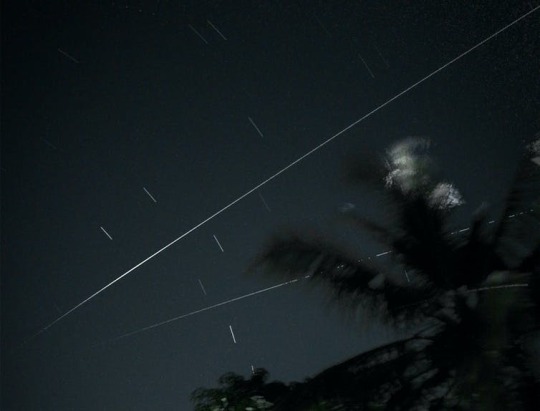
A couple of Lyrids. Flickr/DraconianRain, CC BY-NC
Nowadays, the Lyrids are more sedate, putting on a reliable show without matching the year’s stronger showers. They still throw up occasional surprises such as an outburst in excess of 90 meteors per hour in 1982.
This year’s peak Lyrid rates coincide with the first quarter Moon, which will set around midnight, local time, for most locations. The best time to observe will come in the early hours of the morning, after moonset.
For observers in the northern hemisphere, the Lyrid radiant will already be at a useful altitude by the time the Moon is low in the sky, so some brighter meteors might be visible despite the moonlight in the late evening (after around 10:30pm, local time).
Once the Moon sets the sky will darken and make the shower much easier to observe, yielding markedly higher rates.
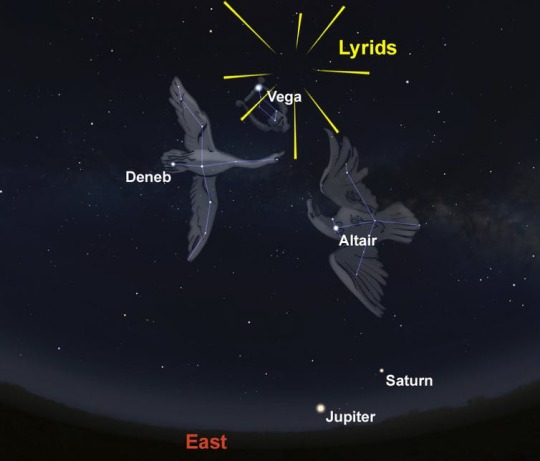
Across the US, the Lyrid radiant is high in the east before sunrise, above the Summer Triangle of Vega, Deneb and Altair. Low to the horizon, Jupiter and Saturn are rising. US around 4am local time. Museums Victoria/Stellarium
For observers in the southern hemisphere, the Lyrid radiant reaches a useful altitude in the early hours of the morning, when the Moon will have set. If you’re a keen meteor observer, it could be worth setting your alarm early to get out and watch the show for a few hours before dawn.
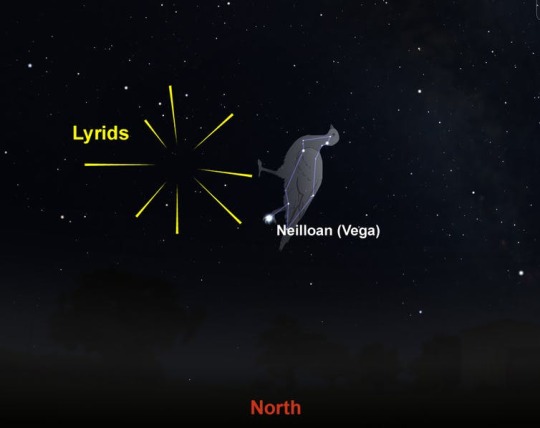
The Boorong from north-western Victoria saw the Lyrids as Neilloan, the Mallee fowl, kicking up shooting stars while preparing her nest. Melbourne, 5am. Museums Victoria/Stellarium
Lyrid meteors are fast and often quite bright so can be rewarding to observe, despite the relatively low rates (one every five or ten minutes, or so). Remember, this shower always has the potential to throw up an unexpected surprise.
Eta Aquariids [S]
Active: April 19–May 28
Maximum: May 6, 3am UTC = 1pm AEST (Qld/NSW/ACT/Vic/Tas) = 11am AWST (WA)
ZHR: 50+
Parent: Comet 1P/Halley
The Eta Aquariids are an autumn treat for southern hemisphere observers. While not one of the big three, they stand clear as the best of the rest of the annual showers, yielding a fine display in the two or three hours before dawn.
youtube
The Eta Aquariids are fast meteors and are often bright, with smoky trains. They are fragments of the most famous comet, 1P/Halley, which has been laying down debris around its current orbit of the Sun for tens of thousands of years.
Earth passes through that debris twice a year, with the Eta Aquariids the best of the two meteor showers that result. The other is the Orionids, in October.
Where most meteor showers have a relatively short, sharp peak, the Eta Aquariids remain close to their best for a whole week, centred on the maximum. Good rates (ZHR > 30 per hour) should be visible before sunrise on each morning between May 3–10.
The Moon will be a waning crescent when the Eta Aquariids are at their best. Its glare should not interfere badly with the shower, washing out only the faintest members.
Observers who brave the pre-dawn hours to observe the Eta Aquariids will have the chance to lie beneath a spectacular sky. The Milky Way will be high overhead, with Jupiter, Saturn and the Moon high to the east and bright, fast meteors streaking across the sky from an origin near the eastern horizon.
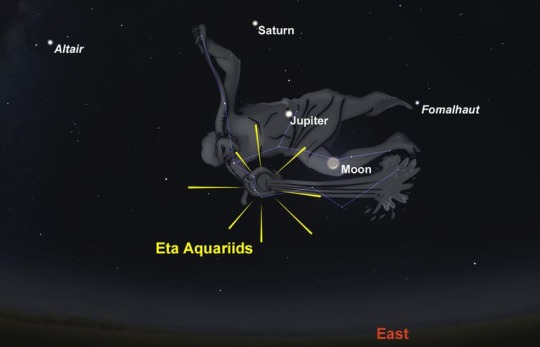
The crescent Moon, the two biggest planets, a couple of bright stars and the Eta Aquariids all in the east before sunrise on May 6. Australia, around 4am local time. Museums Victoria/Stellarium
Perseids [N]
Active: July 17–August 24
Maximum: August 12, 7pm–10pm UTC = 8pm–11pm BST = August 13, 4am–7am JST
ZHR: 110
Parent: Comet 109P/Swift-Tuttle
The Perseids are the meteoric highlight of the northern summer and the most observed shower of the year. December’s Geminids offer better rates but the timing of the Perseid peak makes them an ideal holiday treat.
The Perseids are debris shed behind by comet 109P/Swift-Tuttle, which is the largest known object (diameter around 26km) whose orbit currently intersects that of Earth.

A Perseid crosses the sky over the Teide volcano and Teide Observatory on Tenerife. Flickr/StarryEarth, CC BY-NC
Perseid meteors are fast, crashing into Earth at a speed of about 216,000km/h, and often bright. While the shower is active, at low levels, for more than a month, the best rates are typically visible for at the three nights centred on the peak.

The Perseids radiate from the north-east, with the radiant rising high in the sky during the early hours of the morning. London, 11pm (left) and 4am (right) Museums Victoria/Stellarium
For observers at European latitudes, the Perseid radiant rises by mid-evening, so the shower can be easily observed from 10pm local time, and remains high all through the night. The later in the night you look, the higher the radiant will be and the more meteors you’re likely to see.
Aurigids [N favoured]
Active: August 28–September 5
Maximum: Potential Outburst on August 31, peaking between 9:15pm–9:40pm UTC = 10:15pm–10:40pm BST = 11:15pm–11:40pm CEST = September 1, 1:15am–1:40am Gulf Standard Time = September 1, 5:15am–5:40am AWST (WA)
ZHR: 50–100 (?)
Parent: Comet C/1911 N1 Kiess
Where the other showers are reliable and relatively predictable, offering good rates every year, the Aurigids are an entirely different beast.
In most years, the shower is barely visible. Even at its peak, rates rarely exceed just a couple of meteors seen per hour. But occasionally the Aurigids bring a surprise with short and unexpected outbursts of 30-50 meteors an hour seen in 1935, 1986, 1994 and 2019.
youtube
The parent comet of the Aurigids, C/1911 N1 Kiess, moves on an orbit with a period far longer than the parent of any other shower on our list.
It is thought the orbit takes between 1,800 and 2,000 years to complete, although our knowledge of it is very limited as it was only observed for a short period of time.
In late August every year, Earth passes through debris shed by the comet at a previous passage thousands of years into the past. In most years, the dust we encounter is very sparse.
But occasionally we intersect a denser, narrow stream of debris, material laid down at the comet’s previous passage. That dust has not yet had time to disperse so is more densely packed and hence gives enhanced rates: a meteor outburst.
Several independent research teams studying the past behaviour of the shower have all come to the same conclusion. On August 31, 2021, the Earth will once again intersect that narrow band of debris and an outburst may occur, with predictions it will peak around 21:17 UTC or 21:35 UTC.
Such an outburst would be short-lived. The dense core of the debris stream is so narrow it will take the Earth just ten or 20 minutes to traverse. So you’ll have to be lucky to see it.
The forecast outburst this year is timed such that observers in Eastern Europe and Asia will be the fortunate ones, with the radiant above the horizon. The waning Moon will light the sky when the radiant is above the horizon, washing out the fainter meteors from the shower.

From Europe, the expected peak of the Aurigids occurs just before Moonrise. Be sure to look for the Pleiades whilst watching for any Aurigids – they’re a spectacular cluster of bright stars, commonly known as the Seven Sisters. Vienna, 11:30pm. Museums Victoria/Stellarium

The crescent Moon has risen in Asia at the time the Aurigids peak. Dubai, 1:30am. Museums Victoria/Stellarium
The Aurigids tend to be fast and are often quite bright. Previous outbursts of the shower have featured large numbers of bright meteors. It may just be worth getting up and heading outside at the time of the predicted outburst, just in case the Aurigids give us a show to remember.

While waiting for the Aurigids, the morning sky in Perth is also packed with many famous constellations and bright stars. Perth, 5:30am. Museums Victoria/Stellarium
Geminids [N/S]
Active: December 4–17
Maximum: December 14, 7am UTC = 6pm AEDT (NSW/ACT/Vic/Tas) = 3pm AWST (WA) = 2am EST
ZHR: 150
Parent: Asteroid 3200 Phaethon
The Geminid meteor shower is truly a case of saving the best until last. By far the best of the annual meteor showers, it graces our skies every December, yielding good numbers of spectacular, bright meteors.
The shower is so good it is always worth observing, even in 2021, when the Moon will be almost full.
youtube
Over the decades, the Geminids have gradually become stronger and stronger. They took the crown of the year’s best shower from the Perseids in the 1990s, and have continued to improve ever since.
For observers in the northern hemisphere, the Geminids are visible from relatively early in the evening, with their radiant rising shortly after sunset, and remaining above the horizon for all of the hours of darkness.
As the night progresses, the radiant gets very high in the sky and the shower can put on a truly spectacular show.
For those in the southern hemisphere, the situation is not quite as ideal. The further south you live, the later the radiant will rise, and so the later the show will begin.
When the radiant reaches its highest point in the sky (around 2am–3am local time), it sits closer to the horizon the further south you are, so the best meteor rates you observe will be reduced compared to those seen from more northerly locations.
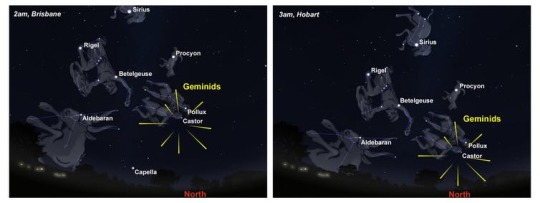
At its highest point, the Geminids radiant sits higher from Brisbane (left) than from Hobart (right), which is why northern observers have a better chance of seeing more meteors. Museums Victoria/Stellarium
Despite these apparent drawbacks, the Geminids are still by far the best meteor shower of the year for observers in Australia, and are well worth a look, even on the moonlit nights of 2021.
Peak Geminid rates last for around 24 hours, centred on the official peak time, before falling away relatively rapidly thereafter. This means that observers around the globe can enjoy the display.
The best rates come when the radiant is highest in the sky (around 2–3am) but it is well worth looking up at any time after the radiant has risen above the horizon.

The Geminid radiant rises at about the following times across Australia., Author provided
So wherever you are on the planet, if skies are clear for the peak of the Geminids, it is well worth going outside and looking up, to revel in the beauty of the greatest of the annual meteor showers.
Jonti Horner, Professor (Astrophysics), University of Southern Queensland and Tanya Hill, Honorary Fellow of the University of Melbourne and Senior Curator (Astronomy), Museums Victoria
This article is republished from The Conversation under a Creative Commons license. Read the original article.
Look up for meteor showers in 2021 published first on https://triviaqaweb.weebly.com/
0 notes
Text
Fuji-San: Climbing the Giant Ice Cream

Many years ago now, I famously applied and failed in a previous quest to live in Japan. Fast forward four years and I'm finally here, living the Japanese Dream in Tokyo Wonderland. It wasn't all plain-sailing though. There was a a bachelor degree, an horrific interview and three years of simultaneously loving and hating life in China to battle through first.
Lets rewind four years. I'm in Edinburgh, Scotland and I'm interviewing for a reputable teaching scheme in Japan. I should be clear here, although I decided I wanted to move to Japan, in the grand scheme of things I had no idea about Japan or even a legitimate reason of substance. Despite having had numerous part-time jobs during my high-school and student years, I'd somehow managed to avoid ever participating in a real job interview. This was only going to lead to disaster. To cut a long study short, I managed to mention the war, Hiroshima and the 2011 tsunami and earthquake which devastated parts of Japan in my interview. I really left myself with less of a chance of moving to Japan than the possibility of a limbless man recreating the Mona Lisa. Six months later I moved to China...

One question I was asked, however, was ‘Where would you like to go in Japan?’ I hadn’t researched anything in particular for this question but there was one big reason I wanted to go to Japan - to climb Mount Fuji. For many, that may not seem like a legitimate reason for moving to another country but I had and continue to have, a strange attraction to Fuji. I’m not about to start rambling to you about some form of weird attraction that you’ll only find in the deepest, darkest corners of the internet, but for me, Fuji possesses a kind of mythical quality that I can’t describe. Whilst Japan is a hugely mountainous region, Fuji rises from the ground like a giant, almost totally isolated in it’s grandeur, unlike other mountainous parts of Japan. Fuji dominates the scenery around it and rises majestically, in it’s conical form, sculpted perfectly by Mother Nature herself.
On a clear day, Fuji is visible from Tokyo which is about a two hour drive from the foot of the mountain. I haven’t been lucky enough to see it yet from so far out but in the crisp, clear, winter days to come, I’ll be looking out with bated breath. The first time I went to Fuji was in April this of this year. Although it’s not possible to climb the mountain at that time because of the temperature and snow capped peak, the surrounding areas are very beautiful and a refreshing break from the claustrophobia of Tokyo. My first impression was, ‘Oh shit.’ I knew I would climb over the climbing period during July and August and when faced with Fuji, rising 3700m into the sky, I could see no way of possibility getting to the top. Due to its conical shape, the peak of the mountain looks almost vertical and it’s hard to imagine getting to the summit without climbing apparatus. Whilst I like to climb the occasional mountain, they usually tend to require nothing more than a pair of running shoes. As the day went on, it became easier to appreciate the sheer size of Fuji and how much impact it has on the surrounding area and Japan in general. I have three year old students who can’t put their own socks on, but even for them, Mount Fuji holds a special significance in Japanese culture. It helps that I also have Mr Potato Head, Fuji-themed socks to spark their interest even further...
So, on a late August afternoon, I climbed aboard a bus from Shinjuku station to Mount Fuji’s fifth station. Whilst it is possible to climb Fuji from the very bottom, the majority of climbers start from the fifth station which is around 2300m above sea level. Although this is higher than I’ve ever been in my life (whilst on two feet), in reality there are only around 1400m to the summit from the start point. We took the option of climbing overnight, beginning at 8pm rather than being extortionately ripped off to stay in a crowded mountain hut for a couple of hours. I had also never climbed at night before which filled me with fear, but in reality, the trails are very good. So as long as you’re careful and have some form of head-torch, the climb is very safe. Mount Fuji is made up of ten stations and by 9pm we had reached the sixth station, already. From that point on, the trail begins to rise rapidly, going from a steady incline to a more vertical incline but it’s still a relatively simple hike. For me, the climb between stations seven and eight were probably the most difficult. This is, effectively, the only part of Fuji that you have to climb. After 12 years of playing rugby and drunkenly falling down stairs at house parties, my knees are verging on dodgy, crumbling messes. During this section you need to climb over large, cliff-like rocks rather than the volcanic gravel trail prevalent on the rest of the mountain. It is also very accessible but whilst my hiking companion seemingly found it simple enough to stay upright, my abysmal lack of balance and sometimes raging winds required me to use my hands at times also. I became a very nonathletic Spiderman. If you’re like me, bring gloves to protect your hands and you will have no problems. And your web blasters.
I should point out that at this point I was terrified. Whilst it was relatively easy to climb up, the incline was extreme and I wondered how the hell I was every going to get back down without smashing my head off every rock on the mountain, as my huge body rapidly rolled to the bottom. It turns out most of the fears I had on the way up were totally irrelevant as the downward path is both different and incredibly easy. In short, don’t worry. By midnight, we were seriously ahead of time and had reached the eighth station at 3100m - only 600m from the top. Until this point, I had actually been climbing in a t-shirt but it was starting to get very cold. Only adrenaline and climbing had protected me for the previous hour or two. Luckily I had packed five extra layers and the further we climbed the more clothes I gradually slipped on. Think of it like a prostitute at work, but in reverse. Sadly also, nobody was paying me for this shit.

Having a rest at the eight station. Notice how we’re still happy and gloves aren’t necessary yet...

During this section of the climb, it was now seriously cold. As long as you kept moving, it was bearable; even pleasant. As soon as you stopped, however, no amount of layers could protect you despite myself looking like the North Face had sponsored Mr. Blobby. A big problem we also had was that we were running out of mountain. At the rate we were going, we would’ve been at the summit by 1.30am, a mere three and a half hours until sunrise. I could only assume that it would be colder at the summit and I didn’t fancy recreating the end of Titanic, except in reverse at 3700m above sea level as some strangers mistakenly referred to me as ‘Jack.’ Bearing this in mind, we decided to find a sheltered spot between the eighth and ninth stations and rest for an hour out of the wind. The mountain staff are surprisingly strict with climbers, to the extent that many climbers could be put in danger. At every mountain hut they will sell Pot Noodles and sometimes other hot food but you’re basically forbidden from coming inside unless you pay the full night’s accommodation fee - around 8000yen. Or £55-£65, depending on what Theresa May’s fair government has cocked up that week. There is plenty of space to shelter climbers from the winds, which are fairly extreme, but I could see it from the other side of the spectrum. Why should they aid mad bastards like us, who chose to climb overnight and encourage others to do the same long term, thus reducing customers and profits? People were so cold that they were hiding in toilets just to stay warm which prompted the addition of a ‘mountain toilet guard’ at one bathroom shack. What I will say is that, you will never take as many unnecessary shits as you will whilst climbing Fuji, simply to get out of the cold and sit down somewhere warm for 5 minutes. Ok, 10...
After an hour long break, we began our ascent to the summit at around 1am, knowing full well we would still be there early, however, staying still was no longer an option. Whilst I couldn’t feel a lack of oxygen in the air, I could feel that with every step and every bend in the trail, it was definitely getting harder. We both reached the ninth station around 2am which is only about 300m from the summit. We were both feeling tired but good and the summit was (probably) in view. All was going well until around 150m from the end. In the space of around ten minutes, my friend went from being slightly tired to physically ill. Headaches and nausea included. Until this point, he had more or less set the pace the whole way but it suddenly fell on me to become Sam and push Frodo up the mountain to destroy Sauron. Or, reach the top of Fuji. It’s the same thing really. Me being me, I hadn’t actually researched altitude sickness at all, hoping everything would just be ok. With that (lack of) knowledge, I figured it was best to push him to keep climbing the mountain and stop him from falling asleep; not really sure if I was helping him or slowly killing him. Every five minutes or so, we would rest for another 5-10 minutes, inhaling the oxygen we’d thankfully invested in pre-hike. By this point, I could see other experienced climbers, who were also clearly struggling and you could tell that everybody was a little bit wrecked. It’s kind of like watching that drunk guy leaving the pizza shop at 4am with his food. He’s walking so slowly and trying so hard not to fall onto the road but you know, somehow, he’ll make it home.

The last 150m took us around an hour - a massive difference compared to the rest of the hike - and we reached the summit around 3.15am, thankfully as the summit huts and shelters were opening up. A total climb of around six hours plus our rest period isn’t bad going. I got a massive buzz off it, so much so that I couldn’t even feel the cold anymore. I was even cheery, something I very rarely am, even at sea level. It felt good to climb higher than I ever had before and although I wouldn’t say it was particularly difficult, it was a massive challenge and a totally new experience. I left my friend in a sheltered hovel while I scoped out the summit and tried to find somewhere we could rest until sunrise. I ended up paying an extortionate amount for the best Pot Noodle I’ve ever had in my life.before going back to reclaim my friend. Thankful that he wasn’t dead, we hung out for an hour in a summit hut, which was wonderfully warm. Whilst he battled to stay awake, clutching a roasting hot green tea, I took the chance to socialise with some other climbers and hope nobody asked me to buy anything. Around 4.30am, it was starting to get light out and we headed outside to watch the sunset. My friend was still in a precarious state and by this point, after being in the warm indoors for over an hour, the effects of the climb had truly worn off. All you could feel now was the cold. So cold, in fact, that I couldn’t enjoy the Kit-Kat which I’d carried up the mountain, specifically to eat at the summit. My optimism went from, ‘Yay, sunrise time,’ to ‘When the fuck is the sun going to come up?’ in the space of about three and a half minutes. My friend took a seat on the edge of the mountain, whilst I moved around the summit, desperately trying to keep warm. The volcanic crater below is both simultaneously impressive and terrifying and not something you want to stray too close to on the windy summit. As the sun began to rise, I returned to my friend who had made his own little addition to the mountain by re-releasing the curry-rice we had consumed before the climb. It’s always good to give back to nature.

The sunrise was a beautiful sight but I was so cold that it was hard to appreciate in a full capacity. It was the first time you get a real sense of how high you actually are, however, and the mountain ranges you pass through on the way to Fuji are dwarfed in comparison. I could see a small mountain I’d climbed four months earlier with my girlfriend to get a good view of Fuji itself and it was like a pimple on the body of the world. Fuji is, well, something else. We began our descent about fifteen minutes after sunrise due to it being fucking baltic and my friend very quickly recovered as we began to descend. The views were wonderful for the first 25 minutes until the descent became potentially the most boring thing I’ve ever done in my life. Two and a half hours descending a path that is both repetitive and slightly too hard on the knees to be comfortable was so monotonous. By the time I got to the bottom I was thoroughly miserable, both due to tiredness and sheer boredom and felt sorry for my companion who had to put up with my foul mood.


Above: The stunning sunrise and other climbers observing the view.
Below: Waiting for my wonderful cup noodle in a climbers hut at Fuji’s tenth station.
Having a well deserved lie down on a very cold mountain top.

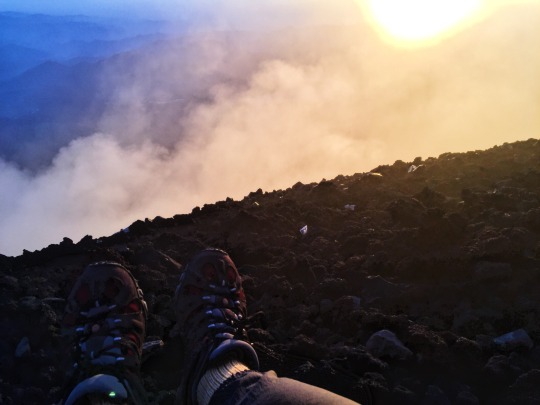
Would I climb Fuji again? The short answer is, I don’t know. Whilst it wasn’t particularly difficult, the cold does really hamper your enjoyment of the experience. Only if I stayed in a hut and could appreciate Fuji’s enormity and views during the day, would I consider doing it again. Climbing overnight was less congested but I could honestly see shit. The feeling of elation and adrenaline I experienced on the final moments before and after reaching the summit though, is something I’ll never forget. I flash-backed to that interview room all those years ago, accomplished in the knowledge that I’d achieved one of the biggest goals I’d ever set myself. But for now, it’s sayonara Fuji!
See more pictures below!

Standing in front of Fuji’s imperious crater. Below was as close as I was willing to get, though.
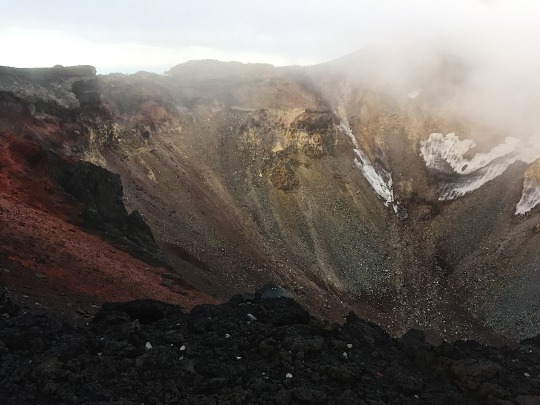
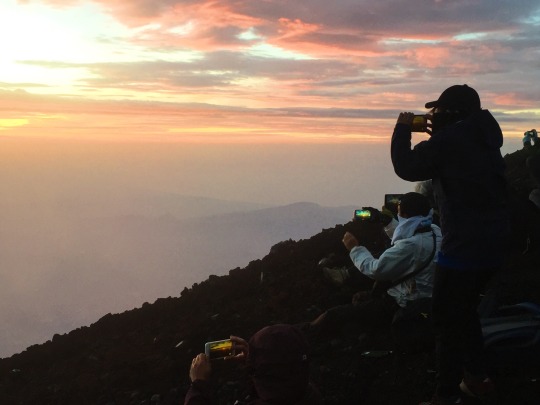
What looked like a moderate sized mountain range on the journey in are made to look minuscule in comparison to Fuji in the sunrise below.

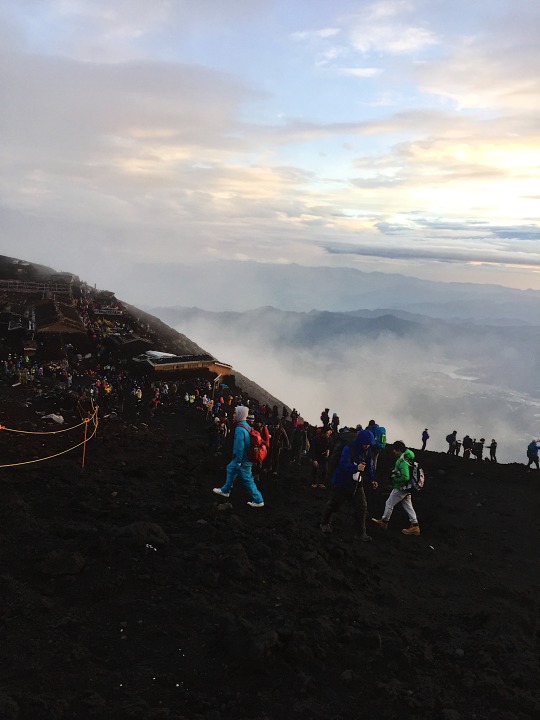
Climbers navigating the summit (above) and the start of the descent (below). I’ve seen worse views, I guess.
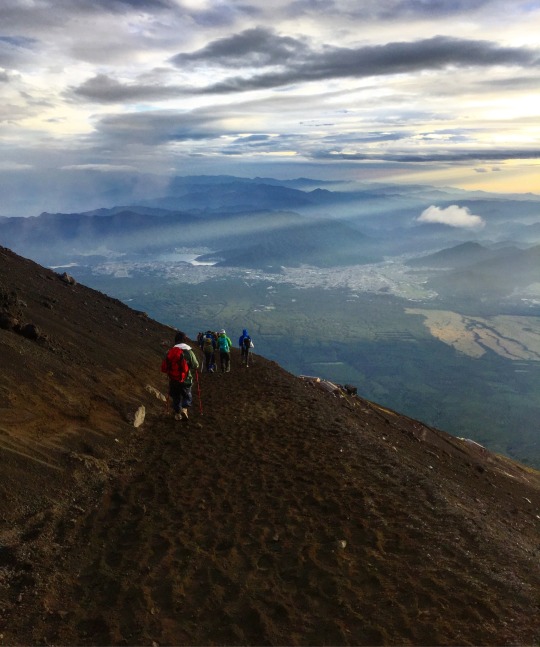

#Fuji#Japan#Climbing#Lit#Blog#Travel Blog#Satire#Funny#Hiking For Dummies#An Ulsterman Abroad#TEFL#Teaching
1 note
·
View note
Text
We crossed spacious streets, with building resembling palaces, in La Rambla promenade; the shops were well illuminated and there was movement and life… I did not decide to go to sleep, even though I wished to, so I could rise early and contemplate, in daylight, this city, unknown to me: Barcelona, capital of Catalonia. – Hans Christian Andersen
One of the most glorious pleasures in life is to travel alone, to enjoy your own company and take life at your own pace. It’s a time to be utterly selfish with your time and priorities, for me its a form of self-care that I hope I never have to stop performing.
Sometimes I take for granted the fact that I am so comfortable travelling alone, in some instances I prefer it, at 24 I spent six months travelling around Europe alone which opened my eyes and my heart to travel and that hour in the morning when the rest of the world sleeps. When the light is more of a glow, the cool air warms around you in a comforting way and the only other souls out respect you peace. This may be the only hour in the day that I stop and enjoy the quiet, my breathes become longer and deeper. My thoughts only focus on the stillness around me, its pure magic and can be found anywhere in the world.
I try and squeeze in one holiday away a year by myself, I happily sit in the picnic having picnics, take myself out for dinner in restaurants I want to visit. Spend hours getting lost around gallies and museums, it gives my soul the freedom it yens for.
I have only ever visited mainland Spain once before and that was my hen do to Benidorm (not even sure you can count that as Spain) of which the only thing I actually remember is getting my then fiances name tattooed on the back of my neck (that is what 12 hours drinking in the sun will do to you). Ironically the tattoo lasted longer than the husband although that a story for another day.
The thing that shocks me most about travelling alone is other peoples reactions “you’re so brave”, “aren’t you scared” and “I couldn’t do that” this is a brave new world and I am pretty sure people of been exploring this plant alone for a good few years now!
Not for one minute do I think I am brave, for me it is as normal as breathing. I know me better then anyone else and I know that I will be royally pissed at myself at the end of my self if I woke up with any regrets. Especially if that regret was because I was waiting for someone else. I get incredibly frustrated watching other people not doing what they want for fear of
Not feeling strong enough to do it alone.
Feeling Silly to do it alone.
No partner.
All my friends are busy.
Very early on I decided I wasn’t going to have children because I wanted to see as much of the world as humanly possible and yes, I know you can do both but you can’t be selfish about both one will always be the comprise. I mean sure I could take children anywhere in the world with me but could I do 3am hikes to watch the sunrise? Stay out drinking until 4am? Or can I jump on the back of a random (hot) Italian guys scooter for a tour of Rome?
Over the last ten years since making that choice I have wondered a couple of times if I did actually or eventually want kids (still don’t) it always comes back to wanting to watch the sunrise is as many counties as possible. It might be a totally selfish reason but surely having a child is a totally selfish decision. People no longer have children to keep the town elders happy they have them because they want a family. I just want to travel as much as possible, as far as possible to every corner of the world even if that is alone (and please no, you may change your mind comments on the kids)
Anyway, I have gotten a bit ranty, back to Barcelona! The things I will do for a cheap flight now involve setting a 2am alarm to get to the airport on time. I only had two nights in Barcelona so wanted to make the most out the time available which meant an early flight out and a late one back which really did actually feel like three full days there. Three days also felt like just enough time there. I have real anxiety about timekeeping, I am ten minutes early (at least 10 minutes) for everything, thanks, dad! So I tend to park at the airport which actually costs a small fortune, at this cost, it cost 50% of the actual holiday cost but least I know I will be there on time and I will have my car nearby, also I think I have control issues.
Part of those control issues also means I have a thing about hotels. In Barcelona, I found a four-star hotel for £57 a night although it was 3 miles out of the city. Its sister hotels in the heart of the heart were a £140 a night almost three times more. For the sake of three miles and my peace of mind (the controlling piece), it was well worth it and technically what I saved could actually pay for me to visit Barcelona again. Luckily there was a train station across the road and around the corner, no more than a four-minute walk from the hotel which involved a ten-minute ride into the city. As a side note their trains actually run to a timetable (insert sideways glance to virgin trains).
I arrived in a very overcast miserable looking Spain, not exactly the blue skies I had been dreaming of but it was still an improvement to the rain/sleet skies of the UK. You can’t take more than ten steps in Barcelona without coming across beautiful architecture.
I am organised in the sense I will look at things to do before I go but relaxed enough to just see how I feel and see what I stumble upon. Unfortunately for you I don’t research places to photograph for the picture gram, I have no crazy clothes/location spreadsheets to follow. Might also be why I have less than 2000 followers. So for the next week, I will be posting all my tourist pictures from Barcelona and hopeful a few less rants!
BARCELONA DAYS We crossed spacious streets, with building resembling palaces, in La Rambla promenade; the shops were well illuminated and there was movement and life… I did not decide to go to sleep, even though I wished to, so I could rise early and contemplate, in daylight, this city, unknown to me: Barcelona, capital of Catalonia.
#10 facts about me#10 things not to do after a break up#50 ways to make Winter happy#52 ideas for self caring#Adventures#Are you happy#Barcelona#Barcelona Spain#Be a happier person#Be happy#be positive#Beauty blog#Beauty blogger#Blessed and happy#Blog update#Blogger favourites#blogger in London#blogger in paris#bloggers#blogging#Blogging career#British blog#british blogger#British lifestyle blogger in London#Can you be happy every day#Change your lifestyle#Cheshire blogger#Cheshire life#city break#city break barcelona
0 notes
Text
Lifestyle changes during early pregnancy
Life looks different when expecting
We all hear about the changes for couples who have a child. Lifestyle changes may actually start early during pregnancy.
I'm very glad to be a few weeks into my second trimester. In a great contrast, my first trimester transformed my body in surprising ways. I became tired and lost my appetite. My body didn't suffer from ongoing nausea. Although a surprising gag reflex meant I couldn't swallow tablets.
Those nasty first-trimester symptoms have all eased up now during my second trimester. I can breathe a sigh of relief. Those first twelve weeks brought a few months of health concerns. Being less physically able to live life, some real lifestyle changes were inevitable.
My life turned upside down from the moment I was expecting. Here are some contrasts for a normal day before and after becoming aware of my early pregnancy.
Sleeping Patterns
There's a stereotype about parents losing sleep after a baby is born. The infant is expected to cry at random times of the night. I didn't predict how my sleep would change within a few weeks of conceiving.
I was a complete night owl in the past. 11pm was an extremely early bed time, by my standards. I normally tried to get shut eye from midnight. Even 1am was alright. 2am was pushing my luck. These patterns didn't change whether I worked 9-5 or not. I just couldn't train my body to have any time zone besides a nocturnal one.
Snoozing times went by a new clock just a couple of weeks after conception, before I had even taken a pregnancy test. There was a scattering of strange wake-up moments at 4-5am. Yes, AM. By 7-8 weeks along, I was almost guaranteed a sunrise wake up call from my body clock. I was just wide eyed and ready for the day before the sunshine emerged.
My body wasn't fully ok with such a change. Energy levels would drop after the first few hours of being awake. By the same time as any corporate office starts opening, I would be really worn out. Clearly I wouldn't be returning to the corporate world during that time. Sleep-working isn't an option.
Then there's the afternoon nap. For me. 3pm became a predictable time for extreme tiredness. That middle of the afternoon would just feel like bed time. What on earth!
Despite the daytime bed rest, I would nonetheless be glued to the pillow around 8pm. Maybe I would last until 9pm when watching a really entertaining TV show. Either way, I would barely last an hour or a few after dinner time.
So there we have it. Pregnancy made me sleepy from 3pm and then again at 8pm. The little human inside my tummy would then wake me up at 4am. All I can say to future baby is: please be grateful.
Not Eating Fancy Meals
My appetite went AWOL during the second month of pregnancy. Instead of traditional throw-up nausea, I just barely wanted to consume food. This made eating out borderline pointless - or at the best, low maintenance.
I visited a pizza place with my husband at the seven week milestone. My appetite vanished. A margherita pizza seemed overwhelmingly filling. It was around the size of a side plate. I gradually ate half of the simple cheesy slices.
That moment summed up two problems that dictated my diet. Firstly, I had an aversion to flavour. All flavour was bad, according to my suddenly sensitive taste buds. Secondly, my portion sizes were suddenly adorably tiny. I was eating like a little kid. Deep down I knew I was going to have a child. But it seemed as though I was becoming child-like with my eating.
On my most sensitive days, I ate just a few crackers with sliced cheese for dinner. That's all I could stomach. I drank small cups of watered-down fruit juice. But I couldn't guzzle down lots of water like I used to. This was a surreal practice in maintaining child-sized meals.
Goodbye to the days of pub food, experimental pizza toppings and indulgent desserts. My diet had became super simple. Was I still fun to be around? Maybe when I was awake.
Not Attending Social Events
The old me loved attending events and being social. That is, until my odd sleeping and eating habits started controlling my days. It's not easy trying to have a social life during pregnancy. I can't be the life of the party when 9pm is my bed time. There was no point in attending networking lunches or snack days when I couldn't eat anything. Plus, with basic physical health dominating my days, I felt like I became less interesting for conversation and small talk. That's why I stopped going out.
It Gets Better
I'm glad to be writing this now at eighteen weeks pregnant. My life is still very different. And no amount of optimism ever compensates for the difficulty I endured. But I never imagined how much better life would become in the second trimester. Things are still different, but better.
My appetite started improving right on schedule, when transitioning from the first trimester to the second. I chose to sit at the dining table for dinner one day, instead of eating in bed. I slowly ate half a burrito for that meal. This simple normal activity showed me how incapable I had been until then. I cried tears of combined resentment and joy. These days during the middle of pregnancy, I generally eat like a normal adult. That feels good.
Sure, my pregnancy diet still changes my food lifestyle. So many foods are off-limits throughout the nine months. The one lesson I wish I learned earlier is this: substitute favourite foods and drinks for pregnancy-friendly alternatives. I don't eat my favourite appetisers - salami and other cold deli meat, along with soft cheeses such as camembert cheese. Those snacks are swapped for swiss cheese and olives. I treat myself to a stemmed glass of flavoured mineral water instead of wine. These simple treats help to serve my personal preferences and desires. Then I can feel more like an individual person. I escape the controlling diet by embracing a slight level of freedom.
I still become tired about half as often as before. My body is growing a baby. That takes energy. But I'm not confined to my bed as much. I try limiting big outings to half a day at the most. At least I get out at all. I now cope with staying up until nine or ten at night. That's not the same as pre-pregnancy. But it's a bit easier. I recently started weekly nights out with my husband. We normally go for dinner and a movie. Before a 'date night,' I try resting prior during most of the day. I'm still not a wild party animal or networking superstar during pregnancy. My life is more settled as I prefer to stay inside. But any step towards balance makes pregnancy more enjoyable.
Keeping an Identity
Us women can keep aspects of our identities and personalities in pregnancy and into parenthood. During that second and third month, I felt like a shadow of myself. So much of my identity was previously tied into community events and tourist-style leisure. Who am I when I'm at home?
Once I regained some energy, I regained gratitude for the remaining meaningful parts of my life. I can always delve into spiritual philosophical thought. Some genuine friends will pick up the phone at any time. Our home decor environment can express values and interests. Peaceful quiet time allows opportunities to explore relaxing music and meditative practices. The slower pace of pregnancy and future parenthood can bring new experiences within existing values and beliefs.
I can't believe my journey is close to the half-way milestone. What do I expect from the later weeks of pregnancy? I'm keeping an open mind. Anything is possible.
0 notes
Text
Admit it?! You sang the title of this blog entry haha. :)
Disclaimer: Please be informed that our blog entry will focus more on beginners / first-timers in mountain-hiking, specifically for Mount Pulag.
Your Pulag trip is coming soon and you have no ideas yet…let this post guide you on the basics & first-hand info, we assure you that all details mentioned are helpful. :)
Is it safe to go on a DIY trip or should I join groups/travel agencies? We planned to do a DIY solo trip but we realized the inconvenience. It’s safer & better to join travel groups when going to Pulag. There are lots of travel groups / agencies on Facebook offering travel packages, explore!
When is the best time to visit? November to February are the ideal months to trek..lesser chance of rain, more chance to see the Sea of Clouds, perfect cold weather. For thrill seekers, February is known as the coldest month here, yiiiii.
3. What if we won’t visit during Nov-Feb? You can still trek during summer time (March to June). But during rainy season (July-September), there’s a greater chance that the national park will be frequently closed. You can always check the condition up there through this Facebook page.
4. What’s so special about Mount Pulag? It’s the 3rd highest peak in the Philippines, known for it’s amazing sea of clouds, epic sunrise, and so on. Dubbed as Playground of the Gods, it’s a host to unique flora & fauna. Don’t worry, you’ll learn more during your DENR pre-climb orientation.
5. Is medical certificate really required? Yes, each visitor must present his/her med cert upon registration at the DENR. Safety first. If you don’t have one, you can also secure this at the nearest hospital, just ask the locals for the direction, med cert costs Php 100.00 per head.
6. Can we skip the DENR portion instead? Nope, all visitors are required to drop by at DENR and register their names. Safety first. This is the part where you’ll also undergo a 30 minute pre-climb orientation. There’s a quiz afterwards so pay attention, joke!
7. Can we finish the trek, we’re just first-timers? This is not a race, always remember that in every group, there will be a different trek pace. Some may be faster while others may be slower than usual. For beginners, Ambangeg-Ambangeg trail is recommended since this is the easiest. It will cost you 4 hours per way, still it depends on your pace. The path is sometimes challenging (muddy, slope, rocky, slippery) but nothing compared to the killer trail called Akiki.
8. What to expect on your travel itinerary?
Midnight – leaving Manila and driving to Benguet province
Around 4am – stopover somewhere in Pangasinan / Baguio
Around 6am – stopover at Bokod, Benguet / secure medical certificates
Around 9am – arrival at DENR *registration, orientation, souvenir shopping, try their Biko.. the best.
Around 12pm – jeepney ride to Ranger Station *do the top-load for added experience
Around 1pm – arrival at Ranger Station / visit the rental stores for last minute fix / set-up at base camp site
Free Time / Socials / Roam around camp site
Around 12am – start trek to Camp 1 (1 hour)
1am – arrival at Camp 1, prepare to enter mossy forest, start trek to Camp 2 (1 hour)
2am – arrival at Camp 2, start trek to Peak 3 or to Tower or to Summit (2 hours)
5am – Aura! Do the trekker pose, unli picture-taking, and of course…witness the sea of clouds & sun rise.
Congratulations, you made it! It’s easier to trek going back to your station than going up to the summit. If your soooo tired, you can also ride the Habal-Habal back to base camp (you’ll spot this motorcycles on the last part of the trail), it’s Php 100.00 per head.
9. What if we won’t reach the summit? Don’t cha worry! You can still see the sea of clouds & pretend like you reached the summit by visiting other nearby peaks or the other meet-up place they call “Tower”. You see, this national park has mountain ranges that gives you a beautiful view in every peak with lesser height & difficulty compare to the summit.
behind me is the summit & another peak
10. Things to bring for Mount Pulag? Never underestimate this place, always be prepared than sorry & cold haha, see below check list:
Important, do not forget these!
Back pack *compact back pack will do & make sure to pack your things smart
Trekking shoes / Running shoes *ordinay rubber shoes / sneakers are not advisable
3 pairs of socks / wool socks *needed especially during sleeping
1 pair of thick / fleece hand gloves *needed especially during sleeping & on the way to summit
Leggings / Leg warmers / Jogging pants *wear this under your trekking pants, 2 layers of pants will do
Trekking pants *advisable to wear & additional insulator
Sweater / Hoodie / Fleece jacket **needed especially during sleeping, 2 layers of jacket will do
Thermal jacket *to protect you from sudden rain during the climb & acts as an additional insulator
Long-sleeve top *2 tops will do
Beanies / Bonnets
Whistle
Flashlight
Raincoat
Medicine & first aid kit
Toiletries
Wet wipes *please don’t forget
Trail food *very important
Drinking water *at least 2 liters per person
Optional, so-so..
Surgical hand gloves *effective insulator under your hand gloves & protects your hands too
Ear muffs *so you look cute
Scarf
Trekking sandals
Trekking poles *especially if you’re a first-timer
Silica gel *protection for your gadgets against moist
Thick / Fleece blanket
For Rent – items you can rent in front of the Ranger station
Tent *Php 300.00 for 3 pax
Sleeping Bag *Php 150.00 per head
Headlamp *Php 50.00 each
Insulator pad / earth pad *Php 50.00 each
We hope that we’re able to help you and set some of your expectations on your upcoming Pulag trip. Do watch out for our next Mount Pulag travel post, soon!
Thanks and please rate :)
For the first time : Mount Pulag Admit it?! You sang the title of this blog entry haha. :) Disclaimer: Please be informed that our blog entry will focus more on beginners / first-timers in mountain-hiking, specifically for Mount Pulag.
#affordable couple getaway#campsite mount pulag#Climbing#couple trip to mount pulag#denr station mount pulag#diy trip to mount pulag#first time at mount pulag#gear rental mount pulag#hiking#jeepney ride to mount pulag#kajaletsgo pulag#mount pulag#mount pulag for beginners#Mountain#ranger station mount pulag#tent rental mount pulag#things to bring at mount pulag#Trekking#weekend getaway
0 notes